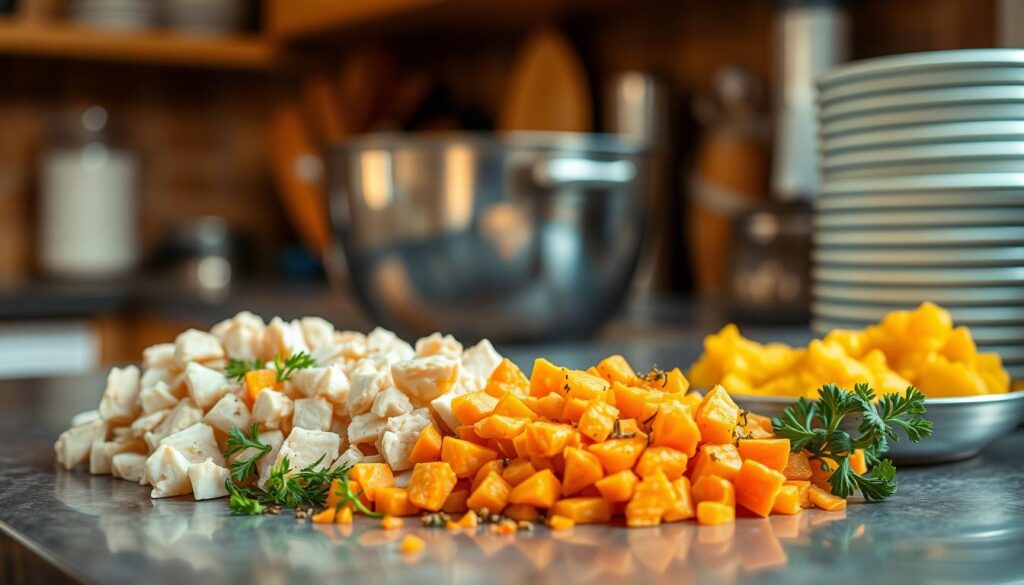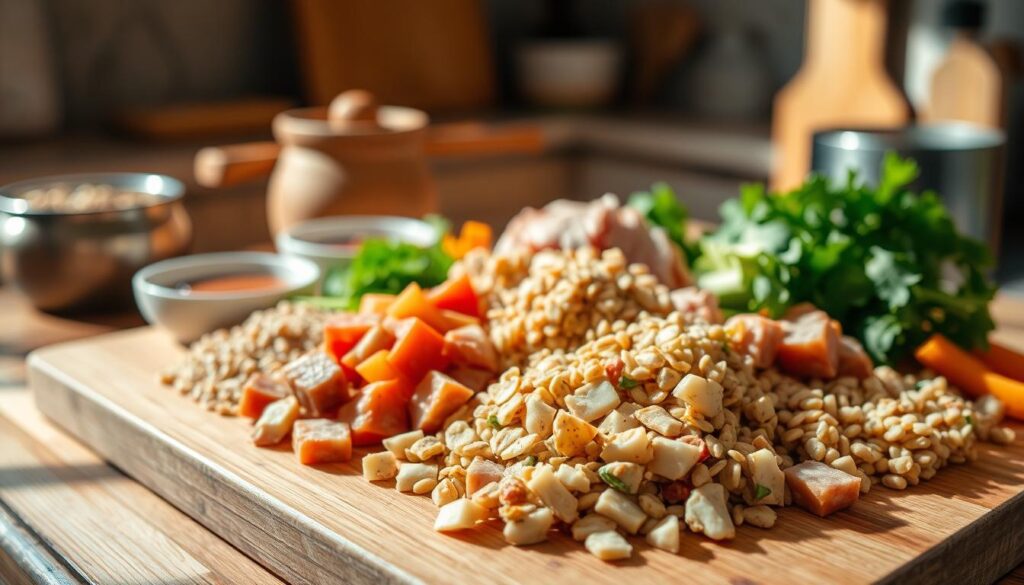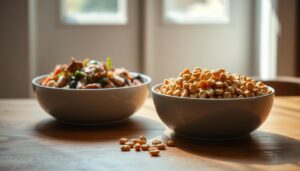As a cat owner, you want the best for your feline friend. This includes their diet. Giving your cat nutritious meals is key for their health and happiness.
By making homemade cat food, you can pick the ingredients. This way, you make sure your cat gets all the nutrients they need. With the right ingredients, you can make tasty and healthy meals for your cat.
Key Takeaways
- Benefits of preparing homemade cat food
- Essential nutrients for cat nutrition
- Simple recipes for homemade cat food
- Tips for transitioning to homemade cat food
- Importance of consulting a veterinarian
Understanding Your Cat’s Nutritional Needs
Cats need a lot of protein from animal sources. Knowing what your cat needs is key to their health. A good diet helps their muscles and keeps them healthy.
Protein is very important for cats. It helps build and fix muscles, organs, and tissues. Cats need more protein than many animals, and it should come from animals like chicken or fish.
The Importance of Protein
Protein is vital for your cat’s health. It keeps their muscles, bones, and skin strong. Without enough protein, cats can get sick and have bad fur.
Essential Vitamins and Minerals
Cats also need vitamins and minerals to stay healthy. These help with energy and keeping the immune system strong. Important ones include Vitamin A, Vitamin D, calcium, and phosphorus.
The following table outlines some essential vitamins and minerals for cats and their functions:
| Nutrient | Function |
|---|---|
| Vitamin A | Supports vision, immune function, and skin health |
| Vitamin D | Crucial for calcium absorption and bone health |
| Calcium | Essential for bone development and maintenance |
| Phosphorus | Important for bone health and many metabolic processes |
Understanding AAFCO Guidelines
The Association of American Feed Control Officials (AAFCO) sets rules for cat food. These rules make sure cat food is good for different life stages, like kittens or adult cats.
When making homemade cat food, following AAFCO guidelines is important. You might need to talk to a vet or animal nutritionist to make sure it’s balanced.
Benefits of Homemade Cat Food
Homemade cat food is great for your cat’s health. You can pick what they eat. This means no bad stuff from store foods.
Health Benefits for Cats
Natural cat food is very good for your cat. It can:
- Make digestion better with easy-to-digest foods
- Lower allergy risks by avoiding common allergens
- Make their fur healthier with fatty acids
Cost-Effectiveness
Many think homemade pet food costs more. But, it can save money over time. Buying in bulk and planning meals helps.
A healthy cat also means less vet bills. This is because diet problems are less common.
Customization for Dietary Needs
Every cat is different. They need food based on their age, health, and how active they are. Homemade cat food lets you make meals just right for them.
Older cats might need less food, while active ones need more protein. Making meals for your cat can make them happier and healthier.
Ingredients for Healthy Cat Food
The base of a good organic cat food is its ingredients. When making homemade cat food, pick the best ingredients. They should give your cat all the nutrients they need.
Best Protein Sources
Cats need a lot of protein from animal sources. Good protein sources are chicken, fish like salmon and cod, turkey, and beef. Make sure to cook these safely for your cat.
Healthy Carbohydrates and Grains
Cats don’t need a lot of carbs, but some grains are good. Brown rice, oats, and quinoa are healthy choices. Cook these grains and mix them with protein for a balanced meal.
Vegetables Safe for Cats
Some veggies are good for cats. Cooked carrots, green beans, and pumpkin are safe. But, give them in small amounts.
| Ingredient Type | Examples | Nutritional Benefits |
|---|---|---|
| Protein Sources | Chicken, Fish, Turkey, Beef | High-quality protein for muscle health |
| Carbohydrates/Grains | Brown Rice, Oats, Quinoa | Fiber, vitamins, and minerals |
| Vegetables | Cooked Carrots, Green Beans, Pumpkin | Vitamins, minerals, and fiber |
Basic Homemade Cat Food Recipes
Want to improve your cat’s diet? Making homemade cat food is a smart choice. You can pick the ingredients and avoid additives in store-bought foods.
Here are three easy and healthy recipes to start with. Each recipe is simple to follow. You can also change them to fit your cat’s tastes and needs.
Simple Chicken and Rice Recipe
This recipe is perfect for beginners. It’s easy for cats to digest and has protein and carbs.
- 1 pound boneless, skinless chicken breast or thighs
- 1 cup cooked white or brown rice
- 1/4 cup finely chopped carrots
- 1 teaspoon fish oil
Put the cooked chicken, rice, and carrots in a bowl. Mix well and add fish oil. Serve at room temperature.
Fish-Based Cat Food Recipe
Cats love fish for its protein and omega-3 fatty acids. This recipe is a tasty way to mix up their diet.
- 1 pound cooked fish (such as salmon or cod)
- 1/2 cup cooked sweet potatoes
- 1/4 cup green beans
- 1 teaspoon flaxseed oil
Mix the cooked fish, sweet potatoes, and green beans together. Add flaxseed oil and serve.
Beef and Pumpkin Stew
This stew is great for cats needing more fiber. Pumpkin is easy on their stomachs and helps with digestion.
- 1 pound ground beef
- 1/2 cup cooked pumpkin
- 1/4 cup cooked peas
- 1 teaspoon coconut oil
Cook the ground beef until browned. Then mix in pumpkin and peas. Add coconut oil and serve warm.
| Recipe | Main Ingredients | Benefits |
|---|---|---|
| Chicken and Rice | Chicken, Rice, Carrots | Easy to digest, balanced protein and carbs |
| Fish-Based | Fish, Sweet Potatoes, Green Beans | High in protein, omega-3 rich |
| Beef and Pumpkin Stew | Beef, Pumpkin, Peas | High in fiber, supports digestive health |

Making homemade cat food is fun and rewarding. You can choose the best ingredients and recipes for your cat’s health.
Raw Diets for Cats
More cat owners are choosing raw diets over traditional cat food. They think raw diets are closer to what cats eat in the wild.
Benefits of Raw Food
Raw diets have some good points, like:
- Improved Digestion: Cats might digest raw food better, which could help with stomach problems.
- Healthier Coat: Raw food’s high protein can make a cat’s coat shiny and healthy.
- Weight Management: Raw diets are often high in protein and low in carbs, helping with weight control.
Risks Associated with Raw Diets
But, raw diets also have big risks, such as:
- Bacterial Contamination: Raw meat can have Salmonella, which is bad for cats and people.
- Nutritional Imbalance: If not made right, raw diets can be too rich or too poor in nutrients.
- Dental Issues: Raw bones can hurt a cat’s teeth, causing breaks or splinters.
Tips for a Balanced Raw Diet
To make a raw diet safe and balanced for your cat, remember these tips:
- Consult a Veterinarian: Talk to a vet before starting a raw diet to see if it’s good for your cat.
- Use High-Quality Ingredients: Pick fresh, top-notch ingredients to lower the chance of contamination.
- Balance the Diet: Make sure the diet has all the nutrients your cat needs. You might need a vet nutritionist’s help.
Knowing the good and bad of raw diets helps cat owners decide if it’s a healthy homemade cat food option for their pet.
Cooking Methods for Cat Food
How you cook your cat’s food matters a lot. It affects the food’s taste and nutrition. Using the right cooking methods can make meals better and healthier for your cat.
Boiling vs. Baking
Boiling and baking are common ways to cook cat food. Boiling cooks food in water. It makes tough meat soft for your cat to eat. But, it can lose some nutrients if you throw away the water.
Baking uses dry heat to cook food. It keeps more nutrients because it doesn’t use water. Baking also makes food taste better. It’s great for making big batches of food to save for later.
Slow Cooking for Flavor
Slow cooking is good for making cat food. It cooks food on low heat for a long time. This makes the food soft and tasty for your cat. Slow cooking also makes the flavors better.
- Enhances flavor
- Tenderizes ingredients
- Preserves nutrients when done correctly
Freezing for Convenience
Freezing is a smart way to keep homemade cat food fresh. It lets you make meals ahead of time. When you freeze, use airtight containers or bags to keep the food good.
- Portion the food into serving sizes.
- Use airtight containers or freezer bags.
- Label the containers with the date.
Using these cooking methods in your cat food recipes makes sure your cat eats well. They get nutritious and tasty meals.
Incorporating Supplements
Adding the right supplements to your cat’s natural cat food can really help their health. When you make their meals, think about what extra nutrients they might need.
Why Supplements Matter
Supplements can fill in any missing nutrients in your cat’s diet. Even if their food is balanced, some nutrients might be missing. Supplements help make sure your cat gets all the nutrients they need.
DIY cat food lets you make meals just right for your cat. Supplements can be a great addition to this.
Recommended Supplements for Cats
Some important supplements for cats include:
- Omega-3 fatty acids for skin and coat health
- Probiotics for digestive health
- Vitamin E for antioxidant benefits
Always talk to a vet before adding supplements to your cat’s diet. This makes sure you’re choosing the best for their health.
How to Add Supplements to Food
Start with a little bit of supplement and add more if needed. You can mix it into their food. Just sprinkle powders on top or add a liquid to wet food.
Watch how your cat reacts to new supplements. Adjust as needed. This way, your cat gets the benefits without harm.
Special Dietary Considerations
It’s important to know what your cat needs to eat. Cats have special food needs that can change as they get older or if they have health issues.
Food Allergies and Intolerances
Cats can get allergies or intolerances to certain foods, just like people. Common culprits include beef, dairy, and fish. Signs can be skin problems or tummy troubles. Finding and removing the allergen is crucial.
Steps to Manage Food Allergies:
- Find the allergen by trying different foods or getting tested.
- Change to a special diet that doesn’t have the allergen.
- Keep an eye on your cat’s health and change their food if needed.
Aging Cats and Dietary Needs
As cats get older, their food needs change. Older cats need less food but more protein to keep their muscles strong. They might also need omega-3 fatty acids for their joints.
“Senior cats need food that helps their aging bodies, often with more digestible proteins and fewer calories.”
Changing their homemade cat food to meet these needs can really help their quality of life.
Weight Management Options
Many cats are getting too fat, which can lead to health problems like diabetes and arthritis. It’s key to manage their weight through diet.
Tips for Weight Management:
- Feed a balanced, calorie-controlled homemade diet.
- Add more fiber to help them feel full.
- Make sure they get plenty of exercise.

By making your cat’s diet fit their life stage and health, you can greatly improve their health and happiness. Whether it’s for allergies, age, or weight, homemade cat food lets you make the right changes.
Transitioning to Homemade Food
Starting your cat on homemade food is a big step. It’s important to do it right to avoid upset stomachs. This way, your cat will get used to the new food easily.
Steps for a Smooth Transition
To switch your cat to homemade food, follow these steps:
- Begin by adding a little homemade food to their usual diet.
- Slowly add more homemade food over 7-10 days.
- Watch how your cat’s stool, appetite, and health change.
- If your cat seems sick, go slower with the change.
Signs of Digestive Issues
Know the signs of stomach problems in cats. These include:
- Diarrhea or loose stools.
- Vomiting.
- Not wanting to eat.
- Feeling very tired.
If your cat shows any of these signs, talk to your vet.
Monitoring Your Cat’s Response
Watch how your cat reacts to the new food closely. Look for signs of better health like shiny fur and more energy. By keeping an eye on your cat, you can make changes to keep them healthy on homemade food.
Switching to homemade cat food needs patience and careful attention. But, it’s worth it for your cat’s health.
Storing Homemade Cat Food
To keep your cat’s homemade food fresh and safe, it’s key to know the best storage tips. Good storage keeps the food’s nutrients and stops it from spoiling or getting contaminated.
Tips for Safe Storage
Start with the right containers for safe storage. Air-tight containers are best because they keep air, moisture, and bad stuff out. Use glass or BPA-free plastic. Don’t forget to label the containers with the food’s prep date.
- Cool the food to room temperature before refrigerating or freezing to prevent bacterial growth.
- Divide the food into portions to make thawing and reheating easier and to reduce waste.
- Store the containers in the coldest part of the refrigerator or freezer.
Duration for Refrigeration and Freezing
How long you can store homemade cat food depends on how you store it. Cooked food can stay in the fridge for 3 to 5 days. For longer, freeze it for up to 3 months. Always thaw frozen food safely.
Reheating Homemade Cat Food
When reheating, make sure to do it safely to avoid bacteria. Reheat the food to at least 165°F (74°C) to keep it safe. Don’t reheat food more than once to keep it quality and safe.
- Thaw frozen food in the fridge or thawing tray, not at room temperature.
- Reheat the food gently, either in the microwave or on the stovetop, stirring often.
- Serve the food at room temperature or slightly warmed, as cats like.
By sticking to these storage and reheating tips, your cat’s homemade food stays healthy and safe. It gives them the nutrients they need for good health.
Common Mistakes to Avoid
When making homemade cat food, it’s important to know what to avoid. Homemade food can be great, but some mistakes can harm your cat. Knowing these mistakes helps keep your cat healthy and happy.
Overloading on Ingredients
Many cat owners add too much of certain ingredients. They think more is better. But, this can upset the balance of nutrients.
Example of Overloading: Too many supplements can be bad. They can cause too much or too little of something important.
| Ingredient | Potential Issue | Safe Amount |
|---|---|---|
| Protein | Kidney strain | 30-40% of daily calories |
| Calcium | Bone and joint issues | 1-2% of body weight per day |
Ignoring Nutrition Balance
It’s key to make sure your cat’s food is balanced. Cats need the right mix of proteins, fats, vitamins, and minerals. If not, they might get sick or gain too much weight.
“A well-balanced diet is crucial for maintaining your cat’s overall health and longevity.”
To get this balance right, learn what cats need. Talk to a vet or a nutrition expert for help.
Not Consulting a Veterinarian
Always talk to a vet before changing your cat’s diet. They know what’s best for your cat’s health and age.
Vets can check on your cat’s health and adjust the food as needed. Their advice is very important for your cat’s safety and health.
In short, homemade cat food is great, but be careful. Avoid adding too much, make sure it’s balanced, and always talk to a vet. With these tips, you can make healthy and tasty meals for your cat.
Resources for Further Reading
If you want to learn more about making food for your cat, there are many places to go. Learning about cat food can help you choose the best for your pet.
Recommended Books
There are books that teach you how to make healthy food for your cat. They have recipes and tips on how to keep your cat’s diet right.
Online Resources
Online, you can find websites and forums about cat food. They have the latest info on natural and homemade cat food. You can also talk to experts and other cat owners.
Expert Forums
Experts and forums are full of tips on feeding your cat right. Joining these groups can keep you updated on new cat food ideas.
FAQ
What are the benefits of feeding my cat homemade food?
Homemade food for your cat can make them healthier. It also saves money and lets you tailor their diet. You can avoid bad stuff in commercial foods.
How do I ensure my cat is getting the necessary nutrients from homemade food?
Make sure your cat gets the right nutrients. Cats need lots of protein from meat. Talk to a vet or animal nutritionist to make a good diet.
What are some healthy protein sources for homemade cat food?
Good protein sources are chicken, fish, beef, and eggs. You can mix them for a balanced diet.
Can I include vegetables in my cat’s homemade food?
Yes, cats can eat some veggies like green beans, carrots, and pumpkin. But add them slowly to avoid upset stomachs.
How do I store homemade cat food to maintain its quality and safety?
Use airtight containers in the fridge or freezer. Label them with date and contents. This keeps food safe and fresh.
What are some common mistakes to avoid when making homemade cat food?
Avoid too many ingredients and ignore nutrition balance. Always talk to a vet to make sure your cat eats right.
Can I feed my cat a raw diet?
Some cats eat raw food, but be careful of germs. If you choose raw, handle it safely and make sure it’s balanced.
How do I transition my cat to homemade food?
Start with small amounts of new food. Watch how your cat does and slow down if needed to avoid upset stomachs.
Are there any supplements I should add to my cat’s homemade food?
Supplements can help make sure your cat gets everything they need. Ask a vet about the best ones and how to use them.
How often should I reevaluate my cat’s dietary needs?
Check your cat’s diet often, especially as they get older or if they get sick. A vet can help with the best diet at different life stages.




